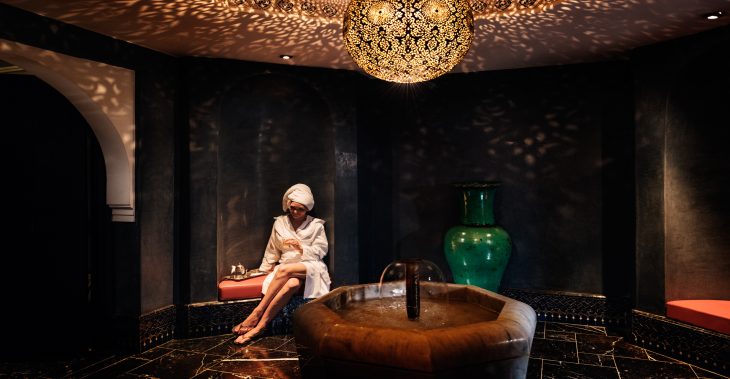
Les Bains D'Agadir
Unveiling the Hammam Experience: Tradition, Benefits, and Modern Adaptations

1. Are Hammam Towels Good?
- Quality and Material: Hammam towels are typically made from high-quality cotton, known for their durability, absorbency, and quick-drying properties.
- Versatility: They are versatile, used not only in hammams but also as beach towels, scarves, or lightweight blankets.
- Eco-Friendly: Being lightweight, they require less water and energy to wash and dry compared to traditional towels.
2. Are Hammams Haram?
- Cultural and Religious Perspectives: In Islamic culture, the concept of hammams being haram is not universally accepted. It largely depends on the practices within the hammam and the adherence to modesty and gender segregation.
- Historical Context: Historically, hammams played a significant role in Islamic societies for hygiene and were not considered haram.
3. Are Hammams Clean?
- Hygiene Standards: Traditional and modern hammams adhere to strict hygiene standards, with regular cleaning of the facilities.
- Personal Hygiene: Users are typically expected to wash themselves before entering communal areas to maintain cleanliness.
4. Are Hammams Private?
- Privacy in Hammams: Traditional hammams have separate times or sections for men and women. Modern hammams may offer private rooms or sessions.
- Cultural Norms: Privacy is a crucial aspect, especially in conservative societies, and is usually well-respected in hammam settings.
5. What are Hammam Towels?
- Design and Features: Hammam towels, also known as peshtemals, are traditional Turkish towels. They are large, flat, and often handwoven with distinctive patterns.
- Usage: Besides their use in hammams, they serve various purposes like beach towels, picnic blankets, or home decor.
6. Is Hammam Good for You?
- Health Benefits: Hammams can improve blood circulation, relieve muscle tension, and promote deep relaxation. The steam and heat can also be beneficial for respiratory issues.
- Skin Care: The exfoliation process in hammams removes dead skin cells, promoting healthier skin.
7. How Often Should You Do Hammam?
- Frequency Recommendations: For optimal benefits without overexposure to heat, a hammam session once a week or bi-weekly is generally recommended.
- Personal Tolerance: The frequency can vary based on individual skin type and tolerance to heat.
8. How Hot is a Hammam?
- Temperature Range: The temperature in a hammam can range from 35°C to 50°C (95°F to 122°F) in different sections.
- Adaptation to Heat: The body gradually adapts to the heat as one moves from the warm section to the hotter areas.
9. What Happens in a Hammam?
- The Process: A typical hammam experience involves relaxing in a warm room, followed by a steam bath, a body scrub, and a massage. It ends with a cooldown period.
- Cultural Experience: In addition to the bathing process, hammams often serve as social spaces in many cultures.
10. Can You Hammam While Pregnant?
- Medical Advice: It’s essential to consult a healthcare provider before visiting a hammam during pregnancy due to potential risks associated with high heat.
- Alternatives: Pregnant women may be advised to opt for milder forms of relaxation and avoid extreme temperatures.
11. How to Use a Hammam?
- Steps to Follow: Start by relaxing in the warm room to acclimatize. Move to the hot room for sweating and then receive a scrub and massage. Finish with a cooldown in the cool room.
- Etiquette: Respect privacy, maintain cleanliness, and follow the hammam’s specific rules and customs.
12. How Hammam Works?
- Functioning Principle: Hammams work on the principle of steam and heat. The steam opens up pores, and the heat induces sweating, which helps in detoxification and relaxation.
- Architectural Design: The architecture, with its domed ceilings and heated marble platforms, is designed to evenly distribute steam and heat.
13. How to Pronounce Hammam?
- Pronunciation: Hammam is pronounced as « hah-mahm, » with emphasis on the first syllable.
14. How to Hammam at Home?
- Creating the Environment: Use your bathroom to create a steamy, warm environment. Light candles and use essential oils for a relaxing ambiance.
- Tools Needed: Get a hammam glove (kessa), quality soap (preferably olive oil-based), and a hammam towel.
- Procedure: Start with a warm shower, apply soap, and use the hammam glove for a thorough scrub. Rinse and wrap yourself in the hammam towel.
15. How to Use Hammam Glove?
- Usage Technique: After soaking in warm water, use the glove to gently scrub your body in a circular motion. This process exfoliates the skin and stimulates circulation.
- Aftercare: Rinse the glove thoroughly and allow it to dry completely to maintain hygiene.
16. How to Do Hammam Bath?
- Steps for Hammam Bath: Begin with a warm shower, then sit in a steamy room to open pores. Use a hammam glove for exfoliation, followed by a soap massage. Rinse and relax in a cooler area.
- Key Elements: Focus on gradual heating and cooling of the body, thorough exfoliation, and relaxation.
17. What is Hammam Spa?
- Definition: A hammam spa is a wellness facility that offers traditional hammam experiences, often combined with modern spa treatments.
- Services Offered: These spas typically provide steam baths, exfoliation treatments, massages, and relaxation areas.
18. What is Hammam Massage?
- Nature of Massage: Hammam massage is a gentle, relaxing massage typically performed after the exfoliation process in a hammam. It often involves the use of aromatic oils.
- Benefits: It helps in further relaxation, improves circulation, and enhances the overall hammam experience.
19. What is Hammam Bath?
- Description: A hammam bath is a traditional bathing ritual involving a sequence of rooms with increasing temperatures, steam baths, body scrubs, and massages.
- Cultural Aspect: It’s an integral part of many Middle Eastern and North African cultures, serving both hygienic and social functions.
20. What is Hammam in Morocco?
- Moroccan Hammam Culture: In Morocco, hammams are deeply ingrained in the culture, serving as communal bathing and social spaces.
- Unique Practices: Moroccan hammams often use specific local products like black soap and rhassoul clay.
21. What is Hammam in Turkey?
- Turkish Hammam Tradition: Turkish hammams, also known as Turkish baths, are renowned for their opulent architecture and the ritualistic bathing process.
- Cultural Significance: They play a significant role in Turkish social life and are known for their elaborate and luxurious bathing experiences.
22. Hammam When Pregnant?
- Precautions: Pregnant women are generally advised to avoid high heat environments like hammams, especially during the first trimester.
- Consultation: Always consult with a healthcare provider before deciding to visit a hammam during pregnancy.
23. Where Did Hammam Originate From?
- Historical Origins: The concept of hammams originated in the Roman and Byzantine empires and was later adopted and adapted by the Islamic world.
- Cultural Integration: Hammams became an integral part of Islamic culture, with adaptations and enhancements to suit local customs and needs.
24. Who is Imaan Hammam?
- Profile: Imaan Hammam is a Dutch model of Moroccan and Egyptian descent. She is known for her work in high-fashion and appearances in international magazines.
25. Why is Hammam Haram?
- Religious Debate: The idea of hammams being haram stems from concerns about modesty and gender mixing. However, this is subject to interpretation and varies across different Islamic communities.
- Modern Adaptations: Many modern hammams ensure gender segregation and privacy to align with religious guidelines.
26. Is Hammam Good for Skin?
- Skin Benefits: Hammams are excellent for skin health. The steam opens pores, and the exfoliation process removes dead skin cells, promoting clearer and softer skin.
- Moisturizing Effects: Post-hammam treatments often include moisturizing, which nourishes and hydrates the skin.



